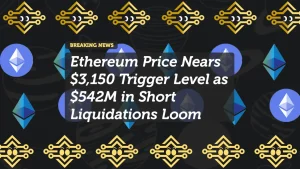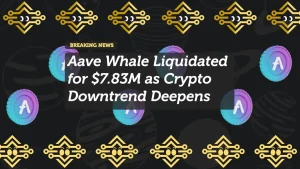
Ethereum and Altcoin Movements: Fee Concerns and Regulatory Uncertainty Shake Crypto Market
The cryptocurrency market has been anything but stable lately, with Ethereum experiencing a slight decline and major altcoins like Cardano (ADA) and XRP suffering significant price drops. Concerns over Ethereum’s fee structures and growing competition from app-specific blockchains have placed pressure on the leading smart contract platform, while regulatory uncertainty continues to weigh heavily on altcoins.
Let’s dive into the factors behind Ethereum’s current challenges, the struggles of altcoins like ADA and XRP, and how the rise of app-specific blockchains is reshaping the crypto landscape.
Ethereum: Facing Pressure from Fee Concerns
Ethereum has long been the dominant player in the world of smart contracts and decentralized applications (dApps). However, the network’s high gas fees have been a recurring issue, especially during periods of heavy usage. Recent developments have brought these concerns back into focus, contributing to Ethereum’s recent price decline.
The Fee Structure Debate
- Despite Ethereum’s transition to Proof-of-Stake (PoS) with the Merge, its fee structure remains a pain point for many users.
- Heavy reliance on layer-2 solutions like Arbitrum and Optimism has somewhat mitigated these issues, but critics argue that Ethereum’s fees make it less accessible compared to newer platforms.
App-Specific Blockchains on the Rise
- App-specific blockchains, like those built on the Cosmos SDK or Polkadot, are gaining traction as developers opt for custom ecosystems tailored to their applications.
- These blockchains offer lower fees and greater flexibility, presenting a direct challenge to Ethereum’s dominance.
Market Impact
Ethereum’s price recently fell by 3-5%, reflecting concerns about its ability to retain market share as competition intensifies. While Ethereum remains the go-to platform for DeFi and NFTs, its leadership position is being tested.
Altcoin Struggles: ADA and XRP Hit by Regulatory Woes
While Ethereum’s decline is tied to competition and technical challenges, altcoins like Cardano (ADA) and XRP are facing a different type of pressure: regulatory uncertainty.
Cardano (ADA): Losing Ground
Cardano has seen a significant drop in value, partly driven by broader market trends and increasing competition. However, regulatory scrutiny is also playing a role:
- Cardano’s decentralized approach and slower development timeline have raised questions about whether it can keep pace with faster-moving competitors.
- Concerns over potential classification as a security under U.S. regulations have further dampened sentiment around ADA.
XRP: Stuck in Legal Limbo
XRP’s price dropped sharply, reflecting ongoing challenges in its legal battle with the SEC:
- Ripple Labs has been embroiled in a lawsuit with the SEC since 2020, with the regulator alleging that XRP is an unregistered security.
- While Ripple scored a partial legal victory in mid-2023, uncertainties surrounding the case continue to weigh on investor confidence.
Market Impact
- ADA has dropped nearly 7% in the past week, as investors question its long-term growth potential.
- XRP has seen a 10% decline, highlighting the risks associated with regulatory overhangs.
The Rise of App-Specific Blockchains: A Threat to Ethereum and Altcoins?
One of the biggest disruptions in the crypto market today is the emergence of app-specific blockchains. These networks, designed to serve specific applications or ecosystems, are attracting developers and users with promises of lower costs and greater customization.
Why App-Specific Blockchains Are Thriving
- Lower Fees:
Unlike general-purpose blockchains like Ethereum, app-specific blockchains are optimized for their specific use cases, allowing them to operate with minimal overhead. - Customizable Ecosystems:
Developers can tailor app-specific blockchains to meet their precise needs, whether it’s a gaming platform, NFT marketplace, or DeFi protocol. - Interoperability:
Platforms like Cosmos and Polkadot enable seamless communication between blockchains, making it easier to build interconnected ecosystems.
Examples of App-Specific Success
- DYDX: The popular decentralized derivatives platform is migrating to its own app-specific blockchain, citing scalability and cost benefits.
- Axie Infinity: A gaming-focused blockchain that has built a dedicated ecosystem for its play-to-earn model.
Implications for Ethereum and Altcoins
As app-specific blockchains gain popularity, they pose a serious challenge to Ethereum’s dominance and could siphon market share from other altcoins struggling to find their niche.
Regulatory Uncertainty: A Cloud Over Altcoin Markets
While technical innovations like app-specific blockchains are reshaping the market, regulatory uncertainty remains a significant risk for many altcoins.
The SEC’s Ongoing Crackdown
The SEC’s aggressive stance on cryptocurrencies has created a challenging environment for projects like XRP and even Cardano. Key concerns include:
- Securities Classification: Many altcoins are at risk of being classified as securities, which would subject them to stricter regulations.
- Compliance Costs: Adapting to new regulatory requirements could burden smaller projects, stifling innovation.
Impact on Investor Sentiment
- Regulatory fears often lead to short-term sell-offs, as seen with the recent declines in ADA and XRP.
- Uncertainty around regulations also discourages institutional investors, who prefer assets with clearer legal frameworks.
What’s Next for Ethereum and Altcoins?
Despite recent setbacks, Ethereum and major altcoins like ADA and XRP remain critical players in the crypto market. Here’s what to watch for in the coming months:
Ethereum’s Path Forward
- Scaling Solutions: The adoption of layer-2 solutions and potential upgrades like EIP-4844 (Proto-Danksharding) could significantly reduce fees and improve Ethereum’s competitiveness.
- Institutional Adoption: Ethereum’s deflationary tokenomics and utility in DeFi and NFTs continue to make it an attractive long-term investment.
Altcoins: Regulatory Clarity is Key
- For ADA and XRP, the resolution of regulatory challenges will be crucial. A favorable outcome in XRP’s legal battle, for instance, could trigger a significant price recovery.
- Altcoins with clear utility and robust ecosystems are likely to outperform in the long run, even amid regulatory pressures.
In Summary
The recent declines in Ethereum and altcoins like ADA and XRP highlight the evolving challenges facing the crypto market. While Ethereum grapples with fee concerns and rising competition from app-specific blockchains, regulatory uncertainty remains a significant hurdle for altcoins.
Key Takeaways:
- Ethereum must address its fee structure to maintain its leadership position in the face of app-specific blockchain competition.
- Regulatory clarity will be critical for the recovery of altcoins like ADA and XRP.
- The rise of app-specific blockchains represents both a challenge and an opportunity for the broader crypto ecosystem.
As the market evolves, projects that adapt to technical and regulatory challenges will likely emerge stronger, paving the way for the next phase of crypto innovation.
FAQs
1. Why is Ethereum facing criticism over fees?
Ethereum’s high gas fees during periods of heavy usage make it less accessible, prompting developers to explore alternatives like app-specific blockchains.
2. What are app-specific blockchains?
App-specific blockchains are customized networks designed to serve specific applications, offering lower fees and greater flexibility compared to general-purpose blockchains.
3. Why have ADA and XRP seen price drops?
Both altcoins are facing regulatory uncertainties, with ADA potentially being classified as a security and XRP still battling its lawsuit with the SEC.
4. Can Ethereum retain its dominance?
While competition is growing, Ethereum’s strong ecosystem in DeFi and NFTs, combined with scaling upgrades, positions it well for long-term success.
















